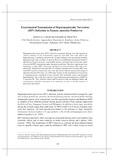Experimental transmission of hepatopancreatic parvovirus (HPV) infection in Penaeus monodon postlarvae
Share
ບົດຄັດຫຍໍ້
Hepatopancreatic parvovirus (HPV) infection in penaeid shrimps was first reported in various countries of the Asia-Pacific region in mid-1980. The virus affects the hepatopancreas of postlarvae and juveniles, usually leading to slow growth and mortality during the early stage of culture. At present, there is no established experimental model of infection in Penaeus monodon, a susceptible species, since there has not been any report of successful HPV transmission under laboratory conditions. Therefore, experiments were undertaken to induce HPV infection by feeding P. monodon postlarvae (PL) with virusinfected PL. Postlarval P. monodon (PL-16), initially examined to be free from HPV, were found HPV-positive 24 hours after they were fed with the infected material. Percentage of infection was from 30% (day 1) to 100% (day 7) based on the examination of wet mounts of hepatopancreas (squashed tissue) stained with malachite green and through histopathology. This is the first report of a successful horizontal transmission of HPV in P. monodon PL. This infection model could be used to study the pathogen further and would permit controlled experiments to be undertaken in order to identify methods of prevention and control.
Suggested Citation
Catap, E.S. & R.D. Traviña. (2005). Experimental transmission of Hepatopancreatic Parvovirus (HPV) infection in Penaeus monodon postlarvae. In P. Walker, R. Lester & M.G. Bondad-Reantaso (Eds). Diseases in Asian Aquaculture V (pp. 415-420). Manila: Fish Health Section, Asian Fisheries Society.

